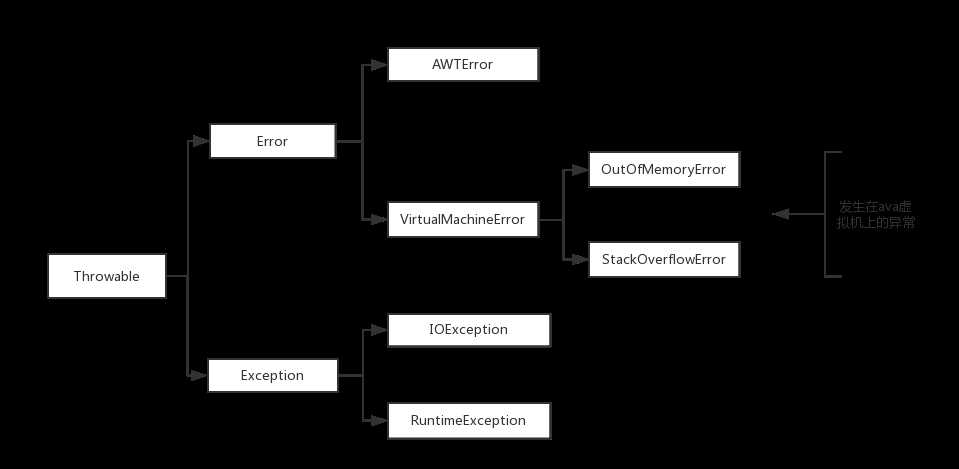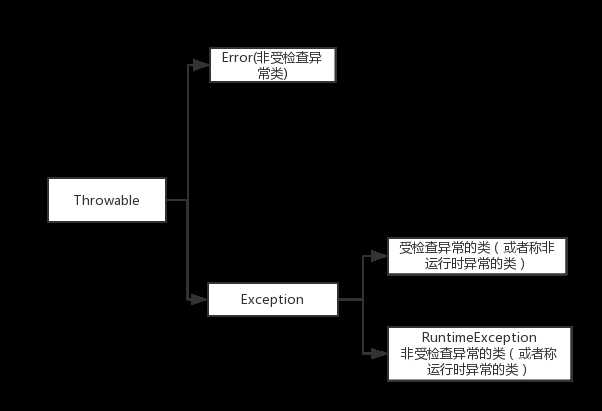本篇主要是记录自己所理解的Java异常处理机制(基于jdk1.7)以及怎么去处理和设计异常。还记得当初学习Java异常这块的时候都没怎么注意它的用途,以为就是简单的处理下异常,我避免程序出现这样错误就行了(当初真的很懵懂很天真)。当踏入社会工作后才知道一个好的异常处理框架是有多重要,比方说当你的项目投入使用的时候,当程序出错如何快速的定位到问题的根源(出了什么错,在哪出的错,为什么出错),这就跟你的异常处理的好坏有关了(当然离不开你的日志处理)。在有效使用异常的情况下,异常类型会回答报的什么错,异常堆栈跟踪回答在哪出的错,异常信息会回答为什么出错。所以如果设计和处理的不好,将会花费大量时间去维护(出现这样的情况公司肯定是不愿意的同时也会质疑你的能力了)。
本篇将从下面几个方面进行记录,如果发现有错误的地方还请各位大佬们指出以便改进,谢谢。
一、Java异常结构
首先你得明白异常是什么,为什么发生异常。通俗的讲,程序异常就是程序出现了错误,而这种错误可能是逻辑上的错误也可能是系统上的错误。在Java中把异常当做对象处理,所以我们要了解在java中有哪些可以类是用来描述异常的,它的层次结构图如下(只描述写重要的类):
二、异常分类及其常见异常类
在java中,所有的异常都是通过Throwable类及其子类传播的(从上面层次结构图中可以看出)。根据层次关系我们依次来分析:
- Throwable:在它下面有两个重要的子类:Error和Exception。它们两个都是重要的异常处理类,但两者分别承担的角色或者针对的对象却不一样,请看下面分析。
- Error:是指程序无法处理的错误,也称unchecked exceptions(未经检查的异常:编译器不要求强制处置的异常)。比如:Java虚拟机运行错误(Virtual MachineError),当 JVM 不再有继续执行操作所需的内存资源时,将出现 OutOfMemoryError。这些异常发生时,Java虚拟机(JVM)一般会选择线程终止。
- Exception:是程序本身可以处理的异常。其中除了RuntimeException及其子类外的任何Exception子类都称为checked exceptions(受检查的异常:编译器要求必须处置的异常)。自然RuntimeException及其子类就归属于非受检查的异常。
/**
* The class {@code Exception} and its subclasses are a form of
* {@code Throwable} that indicates conditions that a reasonable
* application might want to catch.
*
* <p>The class {@code Exception} and any subclasses that are not also
* subclasses of {@link RuntimeException} are <em>checked
* exceptions</em>. Checked exceptions need to be declared in a
* method or constructor‘s {@code throws} clause if they can be thrown
* by the execution of the method or constructor and propagate outside
* the method or constructor boundary.
*
* @author Frank Yellin
* @see java.lang.Error
* @jls 11.2 Compile-Time Checking of Exceptions
* @since JDK1.0
*/
public class Exception extends Throwable {
根据上面Excepiton类还可以分成这两大类:运行时异常和非运行时异常。
- 运行时异常:都是RuntimeException泪及其子类。例如常见类:NullPointerException(空指针)、IndexOutOfBoundsException(下标越界异常)、ArithmeticException(算术异常)、ClassNotFoundException(找不到类异常)、IllegalArgumentException (非法参数异常)等。这些异常也属于非受检查异常。这些异常一般是由程序逻辑错误引起的,程序应该从逻辑角度尽可能避免这类异常的发生。
- 非运行时异常:是RuntimeException以外的异常,类型上都属于Exception类及其子类。从程序语法角度讲是必须进行处理的异常,如果不处理,程序就不能编译通过。例如常见类:IOException、SQLException、ParseException、FileNotFoundException(文件找不到异常)等。
- 综上分类,可以将Throwable划分成这样:

三、异常处理机制
在java中异常处理机制大致为:先抛出异常再捕捉异常。抛出异常一般是交给java虚拟机,当然也可以自己手动抛出异常(下面会涉及到),重点是怎么捕捉异常。
1、捕获异常(try、catch、finally)
捕获异常的形式可能是上面三个的组合,组合形式有:try..catch、try...finally和try..catch..finally
主要记录下try..catch..finally的主要事项:
1.1、其中catch块可以有多个,但要注意捕获异常类的顺序:子类一定要在父类前,否则会编译不通过。
@Test
public void test1() {
int[] arr = {1,3,5,0};
try{
for (int i = 0; i < arr.length; i ++) {
System.out.println(10/arr[i]);
}
}catch (Exception e){
e.printStackTrace();
}catch (ArithmeticException e){//编译不通过。因为异常在前面的catch块中捕获。
e.printStackTrace();
}finally{
System.out.println("end");
}
}
1.2 当catch块中有return时要注意其执行顺序:finally语句在return返回之前执行。
public class ExceptionTest {
@Test
public void test1() {
System.out.println("计算结果:" + sum());
}
public int sum() {
int count = 0;
int[] arr = {1,3,5,0};
try{
for (int i = 0; i < arr.length; i ++) {
count += 10/arr[i];
}
}catch (ArithmeticException e){
System.out.println("计算失败,分母不能为0:" + e.getMessage());
return count;
}finally{
System.out.println("sum() end");//会先执行
}
return count;
}
}
ouput:
计算失败,分母不能为0:/ by zero
sum() end
计算结果:15
1.3 当catch块中有return时要注意fianlly语句对其返回值进行修改时是否影响其返回值:基本类型及其字符串类型是不会被改变的,对象类型下成员变量的值是可以改变的。
1 public class ExceptionTest {
2
3 @Test
4 public void test1() {
5 System.out.println("基本类型mod1()=" + mol1());
6 System.out.println("字符串类型mod2()=" + mol2());
7 System.out.println("对象类型mod3()=" + mol3());
8 }
9
10 public int mol1() {
11 int count = 0;
12 int[] arr = {1,3,5,0};
13 try{
14 for (int i = 0; i < arr.length; i ++) {
15 arr[i] = 10/arr[i];
16 }
17 }catch (ArithmeticException e){
18 return count;
19 }finally{
20 //基本类型修改无效,其实这相当于一个局部变量
21 count = -1;
22 }
23 return count;
24 }
25
26 public String mol2() {
27 String msg = "success";
28 int[] arr = {1,3,5,0};
29 try{
30 for (int i = 0; i < arr.length; i ++) {
31 arr[i] = 10/arr[i];
32 }
33 }catch (ArithmeticException e){
34 msg = "fail";
35 return msg;
36 }finally{
37 //字符串修改无效,其实这相当于一个局部变量
38 msg = "fail, finally";
39 }
40 return msg;
41 }
42 public StringBuffer mol3() {
43 StringBuffer msg = new StringBuffer();
44 int[] arr = {1,3,5,0};
45 try{
46 for (int i = 0; i < arr.length; i ++) {
47 arr[i] = 10/arr[i];
48 }
49 }catch (ArithmeticException e){
50 msg.append("fail");
51 return msg;
52 }finally{
53 //对象类型,其成员变量char[] value;的值是可以被改变的
54 msg.append(", finally");
55 }
56 return msg;
57 }
58
59 }
output:
基本类型mod1()=0
字符串类型mod2()=fail
对象类型mod3()=fail, finally
1.4 当finally语句中有返回值时,会覆盖catch中的返回语句,也会使catch块的throw 抛出的异常失效。(其实不建议使用的)
public class ExceptionTest { @Test public void test1() { System.out.println("基本类型mod1()=" + mol4()); System.out.println("字符串类型mod2()=" + mol5()); } public int mol4() { int count = 0; int[] arr = {1,3,5,0}; try{ for (int i = 0; i < arr.length; i ++) { arr[i] = 10/arr[i]; } }catch (ArithmeticException e){ return count; }finally{ count = -1; return count;//直接返回值,不会在进入catch块中执行 } } public String mol5() { String msg = "success"; int[] arr = {1,3,5,0}; try{ for (int i = 0; i < arr.length; i ++) { arr[i] = 10/arr[i]; } }catch (ArithmeticException e){ throw new ArithmeticException("分母不能为0"); }finally{ //字符串修改无效,其实这相当于一个局部变量 msg = "fail, finally"; return msg;//直接返回值,不会在进入catch块抛出异常 } //return msg; } }
output:
基本类型mod1()=-1 字符串类型mod2()=fail, finally
2、抛出异常,有两种方式:使用throws指定异常,在方法上使用;可以使用throw new 的方法,在方法里使用。不要搞混淆就行。
四、有关设计和处理异常的几个建议(参考Effective Java)
1、只针对异常的情况才使用异常,不要用异常去控制正常流程。(这点我想大部分人不会这么做,但是也列举出来,如果这么做了会引起莫名奇妙的问题)
2、避免不必要的使用受检异常。
3、优先使用标准异常,即错误信息相对应的异常,不要乱抛出异常类否则会找不到问题的根源。比方说有个地方是数组索引超限,你却抛出个参数非法异常,这样就掩盖了原始异常信息。
4、不要忽略异常,即不要使用空catch块。(没有异常信息,就无法找出问题的所在)
5、尽量捕获写细节信息。比方说数组索引越界,它是超过最大索引还是小于0?
